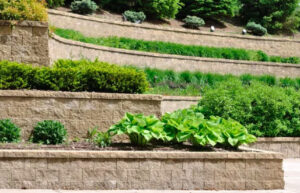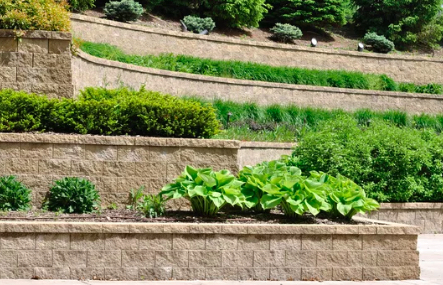In the world of landscaping, there’s a powerful solution to unlocking the full potential of your outdoor space: tiered retaining walls. These multi-level structures not only add aesthetic appeal but also serve a practical purpose by maximizing usable space on sloped terrain. Whether you have a steep hillside or a gently sloping garden, tiered retaining walls can transform your outdoor area into a functional and beautiful oasis. In this comprehensive guide, we’ll explore the art and science of maximizing outdoor space with tiered retaining walls, offering insights, inspiration, and expert tips to make your landscaping dreams a reality. Go to this website at https://www.bricklayerperthwa.com.au/ for more information.
Understanding Tiered Retaining Walls
 Tiered retaining walls, often referred to as terraced or multi-level retaining walls, are a dynamic and practical landscaping solution for properties with sloping terrain. These walls are designed to serve both an aesthetic and functional purpose, offering a unique way to make the most of your outdoor space.
Tiered retaining walls, often referred to as terraced or multi-level retaining walls, are a dynamic and practical landscaping solution for properties with sloping terrain. These walls are designed to serve both an aesthetic and functional purpose, offering a unique way to make the most of your outdoor space.
Tiered retaining walls are a series of individual walls constructed at different levels or tiers on a sloping landscape. These walls are strategically built to prevent soil erosion, manage water runoff, and create multiple flat surfaces, or tiers, on an otherwise uneven or sloped area. The concept of tiered retaining walls is rooted in engineering principles. Still, it has evolved into an art form in modern landscaping, adding both visual appeal and functionality to outdoor spaces.
The Aesthetic and Functional Benefits
- Aesthetic Appeal
Tiered retaining walls add dimension and depth to your outdoor space. They create unique visual interest with different levels for planting, seating, and other decorative elements. You can design your tiered walls to complement your home’s architecture and the natural surroundings, creating a harmonious and picturesque outdoor space.
- Increased Usable Space
One of the most significant advantages of tiered retaining walls is the expansion of usable space. On sloped or hilly terrain, these walls level out the landscape, making it suitable for various activities, such as gardening, outdoor dining, and relaxation areas. You can turn previously unusable areas into functional and enjoyable parts of your property.
Designing Your Tiered Retaining Walls
- Site Assessment
The first step in designing tiered retaining walls is to assess your site thoroughly. Take into account the slope’s angle, drainage patterns, and existing vegetation. This information will help you plan your wall layout, materials, and drainage solutions.
- Material Selection
Choose materials that not only match your design aesthetic but also provide the necessary structural support. Common choices include concrete blocks, natural stone, and timber. Each material has its unique appeal and considerations, so pick one that suits your needs and budget.
- Terraced Garden Beds
Integrate terraced garden beds into your retaining wall design. These beds are perfect for planting flowers, shrubs, or even vegetables. The tiered structure allows for better sunlight exposure and efficient water drainage, promoting healthy plant growth.
Building and Construction
- Proper Foundations
A stable foundation is critical for the durability of your tiered retaining walls. Ensure that the first wall tier is anchored securely into the ground and adequately reinforced.
- Drainage Solutions
To prevent water buildup and soil erosion behind the walls, incorporate proper drainage systems. Options include weep holes, gravel backfill, and drainage pipes. This will safeguard your walls from the damaging effects of excess moisture.
- Sturdy Construction
Building tiered retaining walls involves stacking individual tiers in a stepped pattern. Each tier should be level and securely connected to the one below it, ensuring a solid and stable structure.
Planting and Landscaping
To maximize the beauty and functionality of your tiered retaining walls, consider these landscaping tips:
- Choose plants that thrive in the microclimates created by the various tiers, considering factors like sunlight and moisture.
- Use ground cover plants to reduce erosion on the wall faces and add a lush, green touch to your landscape.
- Incorporate decorative elements like outdoor furniture, lighting, and artwork to make each tier a unique and inviting space.
Maintenance and Care
Regular maintenance is essential to ensure the longevity of your tiered retaining walls. Check for signs of erosion, damage, or leaning walls. Remove weeds and debris from the terraced beds, and consider occasional pressure washing to keep your walls looking their best.
The cost of constructing tiered retaining walls can vary widely based on several factors, including the size of the project, the materials used, labor costs, location, and any additional features you choose to incorporate. It’s important to note that while tiered retaining walls can be an investment, they can significantly enhance your property’s value and usability. Here are some cost considerations to keep in mind:
- Materials: The choice of materials has a substantial impact on the cost. Common materials for retaining walls include concrete blocks, natural stone, timber, and bricks. Natural stone and timber often tend to be more expensive than concrete blocks or bricks. The quality and style of the materials will also affect the overall cost.
- Size and Height: The size and height of the tiered retaining walls directly influence the cost. Taller walls or larger terraced areas will require more materials and labor, resulting in higher costs. Additionally, taller walls may require additional engineering considerations, permits, and reinforcement, which can increase expenses.
- Labor Costs: Labor costs can vary depending on your location, the complexity of the project, and the expertise of the contractors you hire. Skilled professionals may charge more for their services, but their expertise can ensure a high-quality, durable result.
- Site Preparation: The condition of the site before construction begins can also affect the cost. Sites with difficult access, poor soil quality, or the need for significant excavation and grading may require additional work, which can increase the overall cost.
- Drainage Systems: Proper drainage solutions are essential to the longevity and stability of tiered retaining walls. If your project necessitates more complex drainage systems, such as weep holes, drainage pipes, or gravel backfill, these components can add to the overall cost.
- Permits and Regulations: Depending on your location and the size of your project, you may need permits and have to comply with local building codes and regulations. The costs associated with permits and inspections should be factored into your budget.
- Additional Features: If you plan to include features such as lighting, decorative elements, or planting areas within the retaining walls, these will incur additional costs.
- Maintenance and Repairs: While not part of the initial construction cost, it’s important to consider ongoing maintenance and potential repairs to keep your tiered retaining walls in good condition. Regular maintenance can help avoid costly repairs in the future.
It’s advisable to consult with a professional landscaping contractor to get an accurate estimate for your specific project. They can assess your property, discuss your design goals, and provide you with a detailed cost estimate tailored to your unique needs and preferences. It’s also a good practice to obtain multiple quotes from different contractors to ensure you get the best value for your investment.
Tiered retaining walls are a versatile landscaping solution that not only enhances the aesthetics of your outdoor space but also maximizes its functionality. Whether you have a sloping yard or simply want to create visually stunning terraced gardens, these walls can transform your property. With careful planning, quality construction, and thoughtful landscaping, you can create an outdoor oasis that’s both visually striking and highly usable. So, don’t let uneven terrain hold you back – embrace the possibilities of tiered retaining walls and make the most of your outdoor space today.
